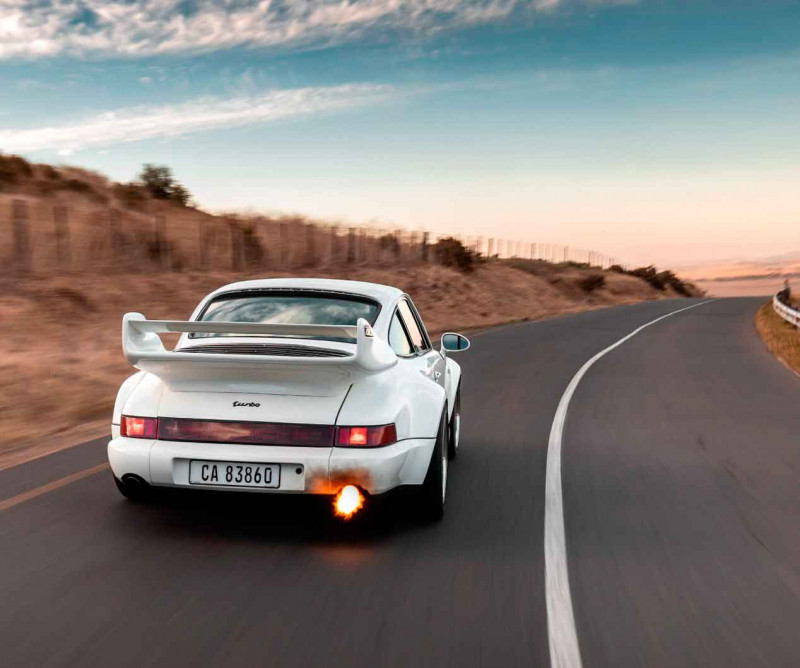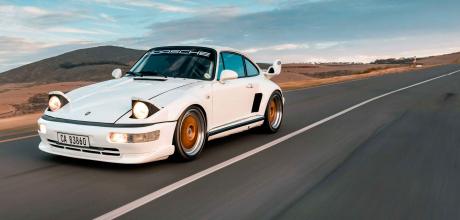1978 Porsche 911 930 SE Flachbau
This 930 Outlaw started life as a Special Wishes Turbo, and has since enjoyed a further programme of unique customisation away from the Porsche factory…
Custom Classic 930 SE
Wilhelm Lutjeharms gets behind the wheel of a 930 SE outlaw and charts the history of the 911 flachbau
The description ‘Widowmaker’ is used far and wide these days, even for cars as modern as a rear-wheel- drive 991 GT2 RS. But, as Porsche aficionados will know, the moniker came from the original 3.0-litre 930 Turbo, a hairy-chested machine that often surprised its pilots by having the rear axle overtake the front when the boost kicked in. Being the first turbocharged 911, it really brought a completely new dimension and driving experience to the 911 genre.

Similarly, Outlaw cars have also evolved to mean a number of different things over the past decade. The basic idea of a car that is not standard, having been individualised by its owner, is only ever half the description. However, combine these two ominous terms – Widowmaker and Outlaw – and you pretty much have the car you see on these pages.
Our 911 in question started life as a Special Wishes Department 930 ‘Flachbau’. This was in 1984. Robert Reister, a Porsche test driver and Special Wishes Department engineer, worked on the car. The next year he was sent to South Africa to become part of Porsche operations there as a workshop manager. It was then that he first noticed the car. By checking its VIN number (WP0222932E5000435), to Reister’s amazement, he realised it was the same 911. This time the 930 cast its spell more intensely and, although only a dream at that stage, Reister decided owning this car would be in his future.
That day came in the late 1990s. At this stage he was a successful businessman and decided to improve its performance – not too difficult a task, given his background as engineer and test driver. 964 RS bumpers were fitted at the front and rear. A 993 RS rear wing was also fitted, and the 911 received a host of mechanical upgrades. These include a 964 turbocharger and camshafts, 935 headers, and an uprated oil scavenge pump. Bilstein dampers in combination with three-piece BBS wheels were fitted, the same components found on Porsche 911 race cars. The massive rear intercooler is larger than standard, resulting in improved intake air cooling.
Thankfully, the car was originally ordered with Option 220, a limited-slip differential, otherwise all of these upgrades would have been much less effective. Interestingly, this option seems to be rather rare among 930 Turbos. Lastly, completing the upgrades list is the same braking system that is found on the 993 Turbo.
During Reister’s tenure with the car he had a few interesting episodes, chief among which was when it caught fire and ruined the dashboard as well as some other interior parts on the driver’s side. Fortunately he managed to get it all repaired. Reister never raced his 930, but attended club events and admits to scaring a number of passengers with the car, even enthusiasts who firstly could not believe how quick the car was and secondly, the limited amount of turbo lag he managed to achieve, taking the 911’s age into consideration. Reister then sold the 930 in 2010 to the its current custodian, who was happy for Reister to take a look around the car as part of our photoshoot today. Reister’s eyes got watery as he walked around the corner and saw the 930 for the first time in 11 years. He was quick to point out all the things that have remained in place, which include even the car’s key ring and the gold crested gearknob!
Back to the car. An Outlaw car is not something that appeals to all 911 enthusiasts, and I include myself in that group. But, as the sun approaches the horizon and we start our photography session of this 930, slowly the car starts to make sense to me, not so much because of the upgrades but more because of the man who made them. As a test driver and engineer at Porsche in the 80s, to me he has an unofficial licence to do such things and is thus somehow qualified to alter 1980s Porsches and add to their pedigree in the process.
As I climb in, the first thing I notice is the full roll cage. Not ideal for road driving in this configuration, but clearly adding to the car’s rigidity. There are also full OMP racing harnesses for both the passenger and driver which, it quickly turns out, is not over the top at all, but very necessary. The seats are 964 RS Recaro carbon-fibre items, trimmed in leather, and they offer decent support and comfort.
The driver’s seat is mounted a little high, the owner informing me that he will be lowering the seats in the near future, but in the longer term they will be perhaps replaced with period correct 930 Turbo seats. Modifications extend further into the interior, with carbon fibre door cards adding some weight-saving measures. Above the dials, a manual system is found to run the engine richer or leaner, connected to a MoTeC ECU. The owner says that this will be changed out along with other improvements he is planning shortly.
The car runs a Patrick racing clutch in combination with a motorsport specification flywheel. On the suspension front we find upgraded three-way adjustable stabiliser bars. So, overall, very little has been left standard on this 930.
However, even though the car has had a hard life and been modified to be a very focused machine, some creature comforts remain in the form of electric windows and, although the sunroof is disabled, it has not been welded shut, so returning it to its original functionality can be done with relatively little effort. Even sitting marginally too high, I still can’t see the nose of the car, even at 6ft2! I need to crane my neck to see those beautiful louvers above the wheel arches. This makes you feel like you are in a mid-engined supercar as there is no sense of a nose in front of you – it feels like the car ends where your feet are. This highlights the driving experience even more as you only see the windscreen and the tarmac ahead of you.
I select the dog-leg first gear on the special five-speed RUF gearbox that Reister procured in the ’90s and pull away. Into second and it is comforting to know that I can shift between second and third without going across the H-pattern ‘box. Even at part throttle there is already an ample amount of torque available. For all the additional performance on offer there is also a pleasing lack of turbo lag. I squeeze the throttle pedal, surge ahead and change gears. An intensely loud ‘wooooshhhhhh’ enters the cabin – without a doubt the loudest dump valve I’ve ever heard in any car! The left side ‘exhaust pipe’ is for exactly that, while the actual exhaust pipe from the engine is on the right. Get off the throttle pedal slower and the sound changes, all depending on your throttle application. It invites you to play around and create your own mechanical symphony.
I press the throttle pedal again as a straight section of the road presents itself and as the rev needle climbs so does the boost from the engine. There is an abundance of torque and power on offer, much more than a standard 930.While one cannot call the power delivery instant, there is some serious shove available from low down, allowing you to make rapid progress without always chasing past 6,000rpm. Under these conditions the car pulls hard, with zero sense of squatting at the rear. Select the next gear and the push from the engine continues with marginally less intensity than the previous gear.
There are some creaks and sounds permeating from the cabin, but that is understandable considering the car’s colourful history. The car is also in need of some cosmetic touch-ups, inside and out, but the owner confirms these will be attended to in the very near future.
Through the corners, the low centre of gravity combined with those wide tyres allow the Flachbau to grip well. It will take a while to really learn the limits of this car, but it can put its power down properly, no doubt helped by the fitment of the limited-slip differential.
Tipping the scales at less than a standard 930 Turbo (1,300kg), the brakes do a good job of scrubbing speed, the pedal feeling firm and providing some welcome feedback. As can be expected, the steering is another highlight. The aftermarket OMP, Alcantara-covered wheel delivers plenty of feel from the front of the car. Then the compact nature of these air-cooled 911s further engraves the driving experience in your mind, occupying such a small footprint on the road. Combine this with excellent visibility, it allows you to perfectly place them on the road and through a corner. It frees your mind to focus on the other elements of the driving experience, especially if it is a 911 as intense as this one.
In its current state it is still a rough diamond, but after driving it and experiencing it I understand why the owner bought it after he drove it. In his own words: “I didn’t actually want to buy the car when the dealer first offered it to me, but then I drove it and it was a done deal, even though I don’t usually like Turbos, or flat noses!”
As the owner of a specialist Porsche workshop and a number of non-standard Porsches, the car fits perfectly into his collection. Let’s not forget that Porsches have always been tuned, upgraded, raced and customised by their owners from day one. All told, a 930 Outlaw is indeed an alluring concept. As Reister told me: “One friend who drove it said he had driven many 930 Turbos, but this car scared him. After all, when I had the car it pushed out up to 650bhp.” However, at that stage the car was running a higher compression ratio, different camshafts and was fitted with forged pistons. All these mods considered, I believe Reister’s claim of achieving an indicated 193mph top speed during one excursion, which means a true speed of at least 186mph!
Back to the current owner: “I’ve never owned a turbocharged 911 before. However, I think this car has been done just right and is so exciting to pilot. The current setup is incredible and being such a light car it leads to a planted feel from behind the wheel. It is also more comfortable and easier to drive every day than you might think. You drive it for a day, and then that night you can’t stop thinking about it,” he says. And when you experience this, you know that a car is impressive, immersive and all-consuming. Three things that an Outlawed Widowmaker must surely be.
Model 930 SE Flachbau
Year 1984
Engine
Capacity 3.3-litre
Compression ratio 7.4:1
Maximum power 400bhp at 6,000rpm
Maximum torque 427Nm at 4,000rpm
Transmission 5-speed manual, RUF gearbox
Suspension
Front MacPherson struts, torsion bars, Bilstein absorbers, anti-roll bar
Rear Semi-trailing arms, torsion bars, Bilstein absorbers, anti-roll bar
Wheels & tyres
Front Bridgestone Potenza RE002 265/35 R18
Rear Bridgestone Potenza RE050 295/35 ZR18
Dimensions
Length 4,291mm
Width 1,775mm
Weight 1,200kg (est)
Performance
0-62mph 5.0 seconds (est)
Top speed 280km/h (est)
ABOVE LEFT 930’s factory 4-speed gearbox has been swapped out for a 5-speed by RUF.
RIGHT Though this 930 has been extensively modified, its flat nose was an option from factory.
FAR RIGHT Recaro Pole Position seats offer the ultimate hold for this turbocharged fire-breather.
“Porsches have always been tuned, upgraded, raced and customised by their owners”


